
An IP QoS architecture for 4G networks
Janusz Gozdecki1, Piotr Pacyna1, Victor Marques2, Rui L. Aguiar3, Carlos Garcia4,
Jose Ignacio Moreno4, Christophe Beaujean5, Eric Melin5, Marco Liebsch6
1 AGH University of Technology, Kraków, Poland ( {pacyna, gozdecki}@kt.agh.edu.pl )
2 Portugal Telecom Inovação, 3810-106 Aveiro Portugal (victor-m-marques@ptinovacao.pt)
3 Instituto de Telecomunicações/Universidade de Aveiro, 3810 Aveiro, Portugal
(ruilaa@det.ua.pt)
4 Universidad Carlos III de Madrid, Spain ( {cgarcia, jmoreno}@it.uc3m.es )
5 Motorola Labs, Paris, France ({Christophe.Beaujean@crm.mot.com, erik@motorola.com)
6 NEC Laboratories, Heidelberg, Germany (marco.liebsch@ccrle.nec.de)
Abstract: This paper describes an architecture for differentiation of Quality of
Service in heterogeneous wireless-wired networks. This architecture applies an
“all-IP” paradigm, with embedded mobility of users. The architecture allows for
multiple types of access networks, and enables user roaming between different
operator domains. The architecture is able to provide quality of service per-user
and per-service An integrated service and resource management approach is
presented based on the cooperative association between Quality of Service
Brokers and Authentication, Authorisation, Accounting and Charging systems.
The different phases of QoS-operation are discussed. The overall QoS concepts
are presented with some relevant enhancements that address specifically voice
services. In particular, EF simulations results are discussed in this context.
1 INTRODUCTION
Availability of the network services anywhere, at anytime, can be one of the key
factors that attract individuals and institutions to the new network infrastructures,
stimulate the development of telecommunications, and propel economies. This bold
idea has already made its way into the telecommunication community bringing new
requirements for network design, and envisioning a change of the current model of
providing services to customers. The emerging new communications paradigm
assumes a user to be able to access services independently of her or his location, in an
almost transparent way, with the terminal being able to pick the preferred access
technology at current location (ad-hoc, wired, wireless LAN, or cellular), and move
between technologies seamlessly i.e. without noticeable disruption.
Unified, secure, multi-service, and multiple-operator network architectures are now
being developed in a context commonly referenced to as networks Beyond-3G or,
alternatively, 4G networks [1]. The 4G concept supports the provisioning of multiple
types of services, ranging from simple network access to complex multimedia virtual
reality, including voice communication services, which are themselves a challenge in
packet-based mobile communications environments.

2 Janusz Gozdecki1, Piotr Pacyna1, Victor Marques2, Rui L. Aguiar3, Carlos Garcia4, Jose
Ignacio Moreno4, Christophe Beaujean5, Eric Melin5, Marco Liebsch6
Due to the heterogeneity of the access technologies, the Internet Protocol version 6
(IPv6) is being targeted as the common denominator across multiple access
technologies, and make the solution basically independent of the underlying
technology - and therefore future-proof. However, fitting such important concepts as
support for Quality of Service (QoS), Authentication, Authorisation, Accounting and
Charging (AAAC) and mobility into the native Internet architecture poses numerous
difficulties and is a real challenge.
Therefore, the primary target of this paper is to present a solution for QoS support
in mobile environments1. In order to do so, we make frequent references to the
problem of integration of QoS, AAAC and mobility. In the course of the paper we
discuss the methods that let us create and exploit the intrinsic associations between
the service level agreements expressed in user profiles, and the network control
mechanisms capable to monitor network usage per service and per user, in order to
provide these services while the user moves and the terminal changes access
technologies. The proposed architecture supports network services, in a secure and
auditable way. Both user-to-network interfaces and inter-operator interfaces are
defined, so that multiple service providers can interoperate. The architecture is able to
support multimedia services, and has been further optimised for voice services. Voice
services are now among the most demanding in terms of network design, imposing
hard limits on network performance. In order to handle these services we will use the
Expedited Forward (EF) concept of the differentiated services framework.
In the next section we briefly describe the network environment. Section 3
describes the overall QoS architecture, while section 4 details the signalling flow of
end-to-end QoS support in the architecture and presents a simulation study that allows
an optimised configuration of the access routers. Finally section 5 recaps our key
conclusions.
2 AN ALL-IP 4G NETWORK ARCHITECTURE
The overall 4G architecture discussed in this paper is IPv6-based, supporting
seamless mobility between different access technologies. Mobility is a substantial
problem in such environment, because inter-technology handovers have to be
supported. In our case, we targeted Ethernet (802.3) for wired access; Wi-Fi
(802.11b) for wireless LAN access; and W-CDMA - the radio interface of UMTS -
for cellular access (Fig. 1). With this diversity, mobility cannot be simply handled by
the lower layers, but needs to be implemented at the network layer. An "IPv6-based"
mechanism has to be used for interworking, and no technology-internal mechanisms
for handover, neither on the wireless LAN nor on other technology, can be used. So,
in fact no mobility mechanisms are supported in the W-CDMA cells, but instead the
same IP protocol supports the movement between cells. Similarly, the 802.11 nodes
are only in BSS modes, and will not create an ESS: IPv6 mobility will handle
handover between cells.
1 The concepts that are presented in this paper have been developed and tested in controlled
environments in the IST project Moby Dick [2] and are currently being refined.

An IP QoS architecture for 4G networks 3
The users/terminals may handover between any of these technologies without
breaking their network connection, and sustaining voice connections. The users can
further roam between administrative domains, being able to use their contracted
services across domains if only appropriate agreements between those domains exist.
The service providers are be able to keep track of the services being used by their
costumers, both inside their own network, and while roaming. This is essential, e.g.
for voice calls charging.
Use r / MT
Domain A
Domain BDomain B
Domain C
NMS
Domain D
W-CDMA
W-C D MA
W-C D MA
802.11
802.11802.11
802.11
Ethernet 802.11 to
Ethernet
802.11
(Intra domain)
802.11
(Inter domain)
W-CD MA
(Intra domain)
W-C D MA
(Inter domain)
W- CD M A
to 802.11
(Inter domain)
AAAC Sys tem
AAAC System
AAAC System
AAAC System
QoS Broke r
QoS Bro ke r
QoS Broker
QoS Broker
NMS
NMS
NMS
PA
PA
PA
AR/AG
AR/A G
AR/AG
AR/AG
AR
QoS Broker
Use r / M TUse r / M T
Domain A
Domain BDomain BDomain B
Domain C
NMSNMS
Domain D
W-CDMA
W-C D MA
W-C D MA
802.11
802.11802.11
802.11
Ethernet 802.11 to
Ethernet
802.11
(Intra domain)
802.11
(Inter domain)
W-CD MA
(Intra domain)
W-C D MA
(Inter domain)
W- CD M A
to 802.11
(Inter domain)
AAAC Sys temAAAC Sys tem
AAAC SystemAAAC System
AAAC SystemAAAC System
AAAC SystemAAAC System
QoS Broke rQoS Broke r
QoS Bro ke rQoS Broke r
QoS BrokerQoS Broker
QoS BrokerQoS B roker
NMSNMS
NMSNMS
NMSNMS
PAPA
PAPA
PAPA
AR/AG
AR/A G
AR/AG
AR/AG
AR
QoS BrokerQoS B roker
Figure 1: General Network Architecture
Figure 1 depicts the conceptual network architecture, illustrating some of the
handover possibilities in such network with a moving user. Four administrative
domains are shown in the figure with different types of access technologies. Each
administrative domain is managed by an AAAC system. At least one network access
control entity, the QoS Broker, is required per domain. Due to the requirements of full
service control by the provider, all the handovers are explicitly handled by the
management infrastructure through IP-based protocols, even when they are intra-
technology, such as between two different Access Points in 802.11, or between two
different Radio Network Controllers in WCDMA. All network resources are managed
by the network provider, while the user only controls its local network, terminal, and
applications.
Summarising Figure 1, the key entities are:
• A user - a person or company with a service level agreement (SLA) contracted
with an operator for a specific set of services. Our architecture is concerned with
user mobility, meaning that access is granted to users, not to specific terminals.
• A MT (Mobile Terminal) - a terminal from where the user accesses services. Our
network concept supports terminal portability, which means that a terminal may be
shared among several users, although not at the same time.
• AR (Access Router) - the point of attachment to the network, which takes the name
of RG (Radio Gateway) - for wireless access (WCDMA or 802.11).

4 Janusz Gozdecki1, Piotr Pacyna1, Victor Marques2, Rui L. Aguiar3, Carlos Garcia4, Jose
Ignacio Moreno4, Christophe Beaujean5, Eric Melin5, Marco Liebsch6
• PA (Paging Agent) - entity responsible for locating the MT when it is in "idle
mode" while there are packets to be delivered to it [4].
• QoS Broker - entity responsible of managing one or more ARs/AGs, controlling
user access and access rights according to the information provided by the AAAC
System.
• AAAC System - the Authentication, Authorization, Accounting and Charging
System, responsible for service level management (including accounting and
charging). In this paper, for simplicity, metering entities are considered an integral
part of this AAAC system.
• NMS (Network Management System) - the entity responsible for managing and
guaranteeing availability of resources in the Core Network, and overall network
management and control.
This network is capable of supporting multiple functions:
• inter-operator information interchange for multiple-operator scenarios;
• confidentiality both of user traffic and of the network control information;
• mobility of users across multiple terminals;
• mobility of terminals across multiple technologies;
• QoS levels guaranties to traffic flows (aggregates), using, e.g. the EF Per Hop
Behaviour (PHB);
• monitoring and measurement functions, to collect information about network and
service usage;
• paging across multiple networks to ensure continuous accessibility of users.
Simple implementations of the above functions, including management aspects,
have been done with the IPv6 protocol stack in Linux. The implementation relies on
MIPL (Mobile IP for Linux). Other network and stack entities required for seamless
operation of terminals in this heterogeneous environment have also been developed.
QoS and AAAC sub-systems are responsible of serving a user according to his service
contract. They operate at the network level and at the service level respectively, and
employ a differentiated services approach for QoS. Fast MIP extension [3] and
security (IPSec) have also been developed and integrated in the network.
3 PROVIDING QUALITY OF SERVICE
The design principle for QoS architecture was to have a structure which allows for
a potentially scalable system that can maintain contracted levels of QoS. Eventually,
especially if able to provide an equivalent to the Universal Telephone Service, it
could possibly replace today's telecommunications networks. Therefore, no specific
network services should be presumed nor precluded, though the architecture should
be optimised for a representative set of network services. Also, no special charging
models should be imposed by the AAAC system, and the overall architecture must be
able to support very restrictive network resource usage.
In terms of services, applications that use VoIP, video streaming, web, e-mail
access and file transfer have completely different prerequisites, and the network
should be able to differentiate their service. The scalability concerns favour a

An IP QoS architecture for 4G networks 5
differentiated services (DiffServ) approach [5]. This approach is laid on the
assumption to control the requests at the borders of the network, and that end-to-end
QoS assurance is achieved by a concatenation of multiple managed entities. With
such requirements, network resource control must be under the control of the network
service provider. It has to be able to control every resource, and to grant or deny user
and service access. This requirement calls for flexible and robust explicit connections
admission control (CAC) mechanisms at the network edge, able to take fast decisions
on user requests.
3.1 Service and Network Management in Mobile Networks
Our approach for 4G networks and to service provisioning is based on the
separation of service and network management entities. In our proposal we define a
service layer, which has its own interoperation mechanisms across different
administrative domains (and can be mapped to the service provider concept), and a
network layer, which has its own interoperation mechanism between network
domains. An administrative domain may be composed of one or more technology
domains. Service definitions are handled inside administrative domains and service
translation is done between administrative domains [6].
Each domain has an entity responsible for handling user service aspects (the
AAAC system), and at least one entity handling the network resource management
aspects at the access level (the QoS Broker). The AAAC system is the central point
for Authentication, Authorization and Accounting. When a mobile user enters the
network, the AAAC is supposed to authenticate him. Upon successful authentication,
the AAAC sends to the QoS Broker the relevant QoS policy information based on the
SLA of the user, derived from his profile. From then, it is assumed that the AAAC has
delegated resource-related management tied to a particular user to the QoS Broker.
However, two different network types have to be considered in terms of QoS: the
core and the access. In the differentiated services approach, the core is basically
managed per aggregate based on the network services, and not by user services. In
that sense, core management is decoupled from the access. We assume that the Core
Network is managed as the ISPs manage it nowadays or with some new management
techniques that might emerge in the future (e.g. aggregation techniques). As a result,
the core will have installed the capabilities required to support a voice-call, e.g..
On the other hand, on the access network, the complexity of CAC can be very
large, due to the potentially complex criteria and different policies. The QoS broker
issues the commands to control both ARs and RGs, configuring e.g. an EF service.
The QoS Broker is thus the entity that interfaces between the user-service level and
the network-service level.
3.2 Implicit "Session" Signalling
In this architecture, each network service being offered in the network is associated
to a different DSCP code. This way, every packet has the information needed to the
network entities to correctly forward, account, and differentiate service delivered to

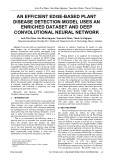

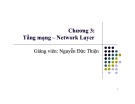
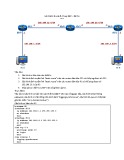


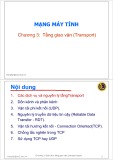

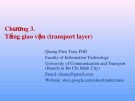

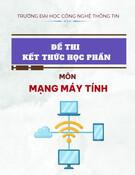
![Đề thi học kì 2 môn Nhập môn Mạng máy tính [kèm đáp án]](https://cdn.tailieu.vn/images/document/thumbnail/2025/20251014/lakim0906/135x160/23811760416180.jpg)



![Câu hỏi trắc nghiệm Mạng máy tính: Tổng hợp [mới nhất]](https://cdn.tailieu.vn/images/document/thumbnail/2025/20251001/kimphuong1001/135x160/15231759305303.jpg)
![Câu hỏi ôn tập An toàn mạng môn học: Tổng hợp [mới nhất]](https://cdn.tailieu.vn/images/document/thumbnail/2025/20250919/kimphuong1001/135x160/30511758269273.jpg)






![Giáo trình Công nghệ mạng không dây (Nghề Quản trị mạng máy tính, Trình độ Cao đẳng) - Trường Cao đẳng Thủ Thiêm [Mới nhất]](https://cdn.tailieu.vn/images/document/thumbnail/2025/20250916/kimphuong1001/135x160/13561758013095.jpg)

